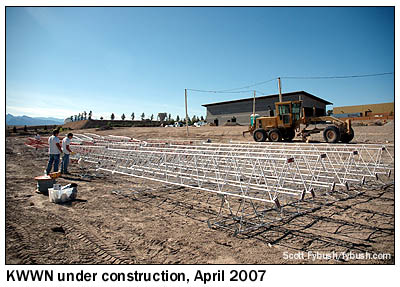
|
|

April 17, 2009
KWWN 1100, Las Vegas, Nevada
 In
most of America's large cities, the AM dial is full to capacity,
and then some. Want to put a new signal on the air in Boston,
or New York, or even Omaha or Tulsa? Good luck with that.
In
most of America's large cities, the AM dial is full to capacity,
and then some. Want to put a new signal on the air in Boston,
or New York, or even Omaha or Tulsa? Good luck with that.
But Las Vegas is different. The city didn't have any radio stations at all until 1940, and even though the AM dial filled up rapidly during Sin City's boom years from the fifties through the seventies, the subsequent breakdown of the clear channels - coupled with the city's relatively isolated location 300 miles or so from any other markets of significant size, over sandy terrain with lousy ground conductivity - meant that frequencies continued to be available for new Vegas AMs all the way up to, well, now.
Just since we started attending the NAB Show in 2001, the Vegas AM dial has sprouted no fewer than three new AM signals; four if you count a construction permit on 620 that expired officially "unbuilt," though it had in fact been on the air, briefly, from a temporary facility that the FCC determined didn't meet the parameters of the CP. There's a granted CP for another frequency, and a pile of pending applications for at least four others, which would make for a crowded market if they all see air.
Over the course of two NAB visits, in 2007 and 2008, we had the great good fortune to be able to follow the construction of one of those new AMs - and as we head to NAB 2009 this week, we're delighted to get to share it with you.
 |
 |
This is "ESPN 1100," KWWN Las Vegas, first applied for in 2003 and granted in April 2005. It's part of the ever-growing Lotus Broadcasting family in Las Vegas, co-owned with two of the city's oldest stations, KENO (1460) and KBAD (920), as well as three FMs.
Our 2007 visit to the site, on Martin Luther King Boulevard in an industrial section of North Las Vegas, found chief engineer Bill Croghan right in the midst of construction. The site had been cleared and graded, the concrete-block transmitter building had just gotten a roof (but was still lacking doors), the tower bases had been poured, the trenches had been dug for transmission lines, and the used tower segments had just been delivered and were in the process of being painted.
By the time we returned a year later, what greeted us was a fully-functional transmitter site (though not quite a licensed one; the license to cover wouldn't be granted for another month, coming through at last on May 8, 2008.)
KWWN uses four 211' guyed towers, cranking out 20 kW by day from two of them and 2 kW at night from all four. By day, the signal fills a big void on 1100 surrounded by co-channel stations in Bakersfield, Grand Junction and Phoenix; at night, the signal is a north-south figure 8 with a deep notch protecting co-channel WTAM in Cleveland.
 |
 |
Building a new site in an urban area presented some interesting challenges for Bill. The city mandated a gated concrete-block wall around the entire property, not to mention a wide paved roadway into the facility and a sizable parking lot for the building.
The building itself is of some interest: it was built much larger than you'd expect for a new AM, in part to provide Lotus with some much-needed storage. A third of the building is used by the promotions and business departments for off-site storage, another third is a big garage for storing promo vehicles and the snowcat that's used in the winter to get up to Bill's FMs atop Mount Potosi, and even the middle third, where the Nautel XR25 transmitter, J1000 backup transmitter and Kintronics phasor are located, has plenty of expansion space (as well as nice-looking woodgrain linoleum flooring.)
Why the extra room? At one point, Lotus contemplated moving its other AMs, now diplexed at a separate three-tower site a couple of miles away, to this location. As it turned out, the only thing that moved was the ESPN format: while 1100 signed on in late 2007 with ESPN Deportes Spanish-language sports, Lotus did a three-way shuffle in early 2008 that moved ESPN from KBAD 920 to KWWN 1100, Fox Sports from KENO 1460 to KBAD, and ESPN Deportes from KWWN to KENO.
One more note before we move on: if you're reading this during NAB, and you decide to make the drive up MLK Boulevard to take a peek at this new site, you might think you're approaching a five-tower site, not four. What looks from a distance like the fifth KWWN tower is actually a slightly older site right next door, bordering the KWWN site on the south. That single 253' tower went up in 2003 for KSHP (1400 North Las Vegas), which moved from another tower that still stands east of MLK, and later became the diplexed home of KDOX (1280 Henderson), which had been operating from a site down in Henderson. Yes, there's plenty of detuning going on at both sites!
- Previous Site of the Week: Palm Springs (Part II)
- Next Week: Mount Arden, Las Vegas
- Site of the Week INDEX!
- How can you help support Site of the Week? Click here!
- Submit your suggestions for a future Site of the Week!
